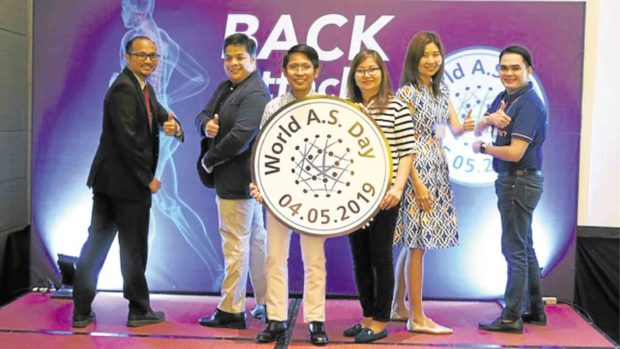
Don’t be quick to dismiss back pain as a natural part of aging, or just one of those annoying problems you learn to live with.
Chronic back pain is not normal. It’s a condition that shouldn’t be left untreated.
It may be a symptom of ankylosing spondylitis.
An inflammatory disease known as a “back attack,” ankylosing spondylitis can cause some of the vertebrae in the spine to fuse, making it less flexible. This leads to a hunched posture. If the ribs are affected, breathing can be difficult.
“Despite the seriousness of this disease, awareness of ankylosing spondylitis is very low. Early diagnosis is crucial,” said Christine Fajardo, Asia cluster patient advocacy head of Novartis Healthcare Philippines.
“Everyday movements like walking, bending and twisting can be difficult and painful to do for someone with ankylosing spondylitis.”
Novartis Healthcare Philippines teamed up with the Philippine Rheumatology Association and patient group Ankylosing Spondylitis Association of the Philippines, and held several activities last week to celebrate World Ankylosing Spondylitis Day 2019.
“Ankylosing spondylitis is not rare, but it’s important we find them because this usually afflicts people in their most productive years,” said Dr. Evan Glenn Vista, board member of the Philippine Rheumatology Association.
“Data shows that if it’s not diagnosed early, a patient will have a permanent deformity. If the bones have fused, that’s already permanent,” added Vista.
Part of the problem, Vista pointed out, is detecting the disease early, since one of its symptoms, back pain, is an affliction that affects everyone at some point in their life. Anyone with an ergonomically challenging situation in the office, for instance, will experience back pain. Most of these back pains are not serious in origin.
“There are many causes for back pain, including some forms of cancer,” said Vista. “That’s why it’s hard to diagnose ankylosing spondylitis. If you look at the global prevalence, less than 1 percent is part of spondyloarthritis.”
Inflammatory diseases
Spondyloarthritis is the umbrella term for inflammatory diseases that involve the joints and the entheses (where the ligaments and tendons attach to the bones).
“Ankylosing spondylitis occurs if the back pain includes fever for no particular reason,” said Vista. “Some patients experience unexplained weight loss of 5-10 percent of the body weight for three months.
“If sleep is disrupted because of nocturnal back pain, if there’s localized bone pain, a bladder or bowel incontinence, and muscle weakness, then it’s time to have it checked,” Vista said.
For engineer Clark Ferrer, who was diagnosed in December 1997, ankylosing spondylitis first manifested as an unexplained pain in the lower hip. Since then he has been bedridden seven times, gone through pain and physical therapy, and even had surgery for aortic regurgitation, a leaking in the aortic valve of the heart.
Ankylosing spondylitis increases the risk for heart disease and stroke to up to 60 percent, particularly for people between 20 to 39 years old.
It raises the risk for many types of heart disease, including heart attack, chest pain, valve disease, and heart failure.
Inevitable progression
The progression of the disease is inevitable. There is no cure for ankylosing spondylitis, but treatments can lessen the symptoms and possibly slow down progression of the disease.
Early signs and symptoms of ankylosing spondylitis might include pain and stiffness in the lower back and hips, especially in the morning and after periods of inactivity. Neck pain and fatigue also are common.
Over time, symptoms might worsen, improve or stop at irregular intervals.
“Most common are hip and pelvic pain, with the pain radiating up to the neck,” said Vista. “Ankylosing spondylitis is often diagnosed at least one decade from the time of the first symptom. By then the joints would have taken some form of damage.”
Most commonly affected areas are the joint between the base of the spine and pelvis, vertebrae in the lower back, entheses, the spine, the back of the heel, the cartilage between the breastbone and rib, and the hip and shoulder joints.
Ankylosing spondylitis affects men more often than women. Seek medical attention if there’s low back or buttock pain that comes on slowly, is worse in the morning or wakes you from your sleep at night, especially if the pain improves with exercise and worsens with rest.
Consult an eye specialist immediately if eyes turn red and painful, or if you experience severe light sensitivity or blurred vision.
New bone will form as part of the body’s attempt to heal in severe forms of ankylosing spondylitis. This new bone gradually bridges the gap between vertebrae and eventually fuses sections of vertebrae so the spine becomes stiff and inflexible.
Fusion can also stiffen your rib cage, restricting lung capacity and function.
That’s why many people with the disease hunch forward due to weakening of certain muscles of the spine. In advanced cases, the inflammation is so bad, patients are unable to lift their head to see in front of them.
Ankylosing spondylitis has no known specific cause, but genetic factors seem to be involved. People who have the HLA-B27 gene are at greatly increased risk of developing the disease.
“The earlier we catch them, the more they can live a productive life. The key is to get an early diagnosis, an early referral, and prompt management,” Vista said.